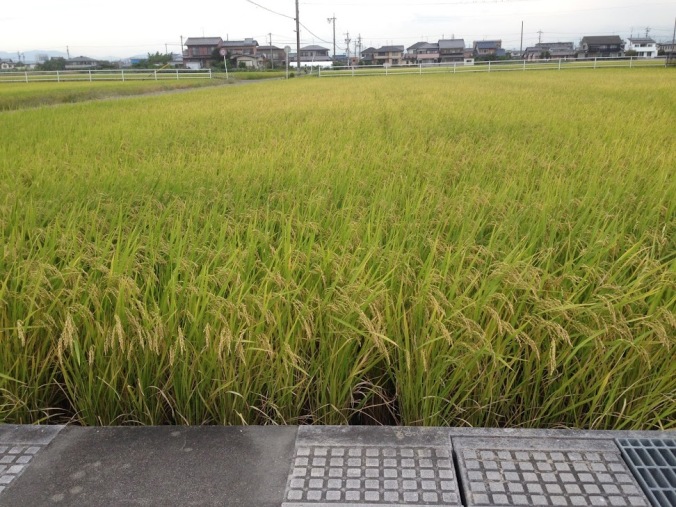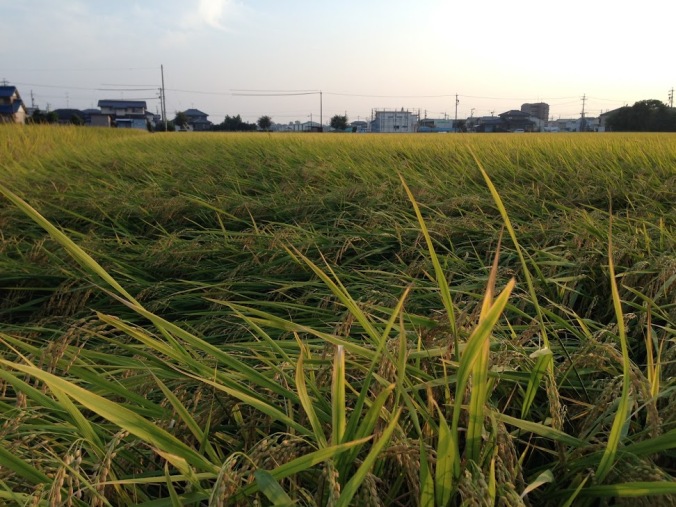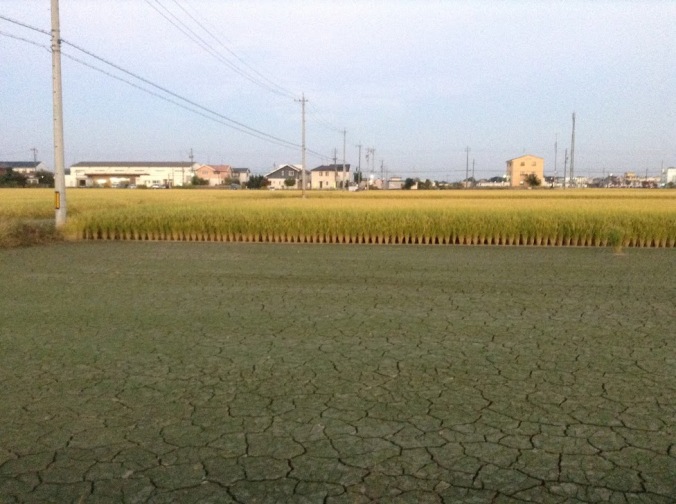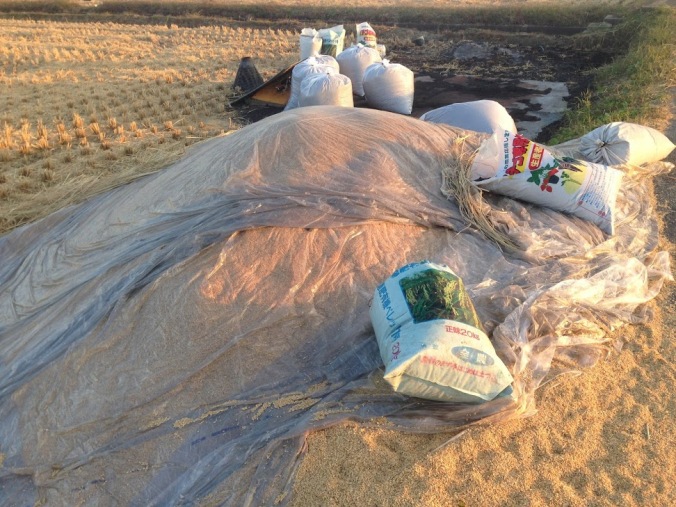Katakana will make its final appearance soon, but today, rice 米 (こめ kome)/御飯 (ごはん) gohan. It can also be translated as ‘meal,’ as in not wheatmeal or oatmeal but breakfast, lunch, etc. One Japanese word for breakfast is ‘morning rice.’ It’s part of the national identity, and I think the government has requirements for how often rice has to be served in school lunch (as opposed to bread or noodles) for primary/elementary and middle schools.
There are a lot of different kinds of rice. In Australia you can get quite a few. You can choose long grain, medium grain or short grain… basmati, jasmine, calrose, arborio, wild rice, black rice, and others. Increasingly, you can get brown (i.e. wholegrain) versions of these. Most rice in Australia is imported. Doongara is the only kind grown in Australia that I know of. Australia is pretty short on water, and most kinds of rice need a fair bit of water to grow, so it doesn’t make sense to grow them in Australia. Apparently Doongara rice needs less water? But most kinds need lots. So rice paddies are kind of basins sunk into the ground. Here is one in April (spring) before they’d started working on this year’s crop. You can see how the ground level in the rice paddy is below the level of the road.

When it gets to sometime in April, May or June, depending on where you live, they fill up the rice paddies with water.

4 June
In Japan, rice is rice. There are different names of rice, but to me, they all look exactly the same, and most of them taste pretty much the same too. Maybe the names are just the grade and/or where they’re grown. Some places are famous for having high quality rice, but I saw a variety show on TV with blind taste testing for low, medium and high quality rice, and out of about 6 participants (all Japanese), only 2 or 3 guessed correctly which was which. In my own experience, in 2 years living in Japan, only once have I had rice that tasted bad, and that was in a shop where they also made fried squid taste bad.
In Japan, ‘rice’ means white Japanese rice. Maybe you know it as sushi rice. The grains are short and they hold a lot of water and stick together really well, which is how Japanese rice is so easy to eat with chopsticks. (Unless you put some kind of sauce on it, in which case most Japanese people will eat it with a spoon.) Some shops sell brown rice, but it’s not very common. Also, I don’t think I have ever seen other varieties of rice (jasmine, basmati etc.) in Japan.

6 June
They have little punnets of rice, and they use these funny tractor things for planting. They look pretty funny when you see them driving on the road, on the way to the paddies. You can see a video about it here.

Punnets/trays of rice plants waiting to be planted
Does it dry out? Not much chance of that. June is the rainy season, and many of the rice paddies probably don’t even need to be filled from wherever they are filled from – the little irrigation channels you can see around the place. There is so much water in Japan! And summer is extremely humid, especially if, like me, you’re from a dry place. There is plenty of life in the water of the rice paddies.
Once planted, as far as I can tell, there is a fair bit of just letting the rice grow.

14 July
The place becomes a bit nicer when it’s all green, and it starts to get taller.

10 August
Then it starts to make these great brushy whispering noises with these warm breezes blowing through it. Or typhoons, as the case may be.

10 September
The colour of the grains at this point is quite pale and/or purply.

10 September
It starts to get floppy.

10 September
Then it starts looking less green and more – well, I’d like to say gold, but really, it’s more yellow. Like the colour of an old lime?

5 October
The grain colour doesn’t change that much, but they get slightly floppier. However, the stalky/leafy part gets yellower, floppier and kind of deader, lower down.

9 October
It gets pretty unruly-looking.

9 October
It looks pretty great at the right time of day – stops looking that sick, greeny yellow, and starts to look more golden.

Sometimes it looks like a dog has flopped down and had a sleep on it. As much as half the paddy, for some of them.

21 October.
So then, time for a haircut.
Because of timing issues, I didn’t manage to get a shot of that harvest machine in action, but Rachel and Jun made a video about it, too, so if you’re interested (Mum!) have a look. It’s pretty cool. The rice goes in a mouth at the front, the machine grabs the bunch somehow and cuts it off from the ground, and also takes the grains off. It puts the grains into a compartment somewhere until they can be transferred to a big bag or something for transport. It also ties a bow around the bunch of now grainless stalks and deposits the bunch on the ground behind it.
The place has dried out a bit by this point.

19 October
The bunches of straw that get left on the ground… what do they do with them? I assume someone makes them into tatami and other straw products (hats, window shades for summer?). Before that happens, though, people dry out their straw in a number of ways.
Some stand it up in little tents or doll shapes. Most hang it up on a rack, made of bamboo, plastic or metal.

21 October
Maybe this lot has gone through the process already. After a while, someone takes it away.

Then you have all this sad old stubble on the ground, which gets burnt off, after which it’s just black and still there. It makes a lot of smoke that comes into your house/work/school if you open the windows.
There are piles of rice – or is this just husks? I don’t know enough to say – on the ground in some places, too. They eventually disappear too.
The rice gets taken somewhere, shelled, and polished to make the white rice most of the country eats. I don’t know what happens to the husks. Maybe they’re exported for other countries to make rice bran oil. I haven’t seen rice bran in the shops here, or rice bran oil. (The idea of whole grains hasn’t really caught on yet in Japan, but you can buy wheat bran in some more uppity supermarkets.)
This is what we have until next spring. Well, presumably everyone’s going to turn over the dirt at some point like the person with the left rice paddy here has done.






You’ve learned a lot about rice in Japan, amazing me to take a shot every period around the rice field. I like to eat white rice with some brown rice, ancient seed rice called 古代米 kodaimai, red,purple or brown, to my favor. I’d like to take nutrition from germ and bran.
You wondered a lot of husks were thrown away in the empty rice field after the harvest. Most of farmers, these days, dry the harvest rice with machine and just after that the husks are taken away with the machine. As far as I know, there is no way to utilize husks. Burning husks are I think prohibited because it pollutes the air and smoke the street.
But we use bran traditionally for making pickles, nukazuke ぬか漬け. For me I use when I cook bamboo shoot at the first stage of cooking. These days bran seems to be good for skin. You may find the cosmetic used bran. The straw is also traditionally used for house wall ( mix fine cut straw and mud). Anyway, I hope the straw, husks,bran and roots are all plowed with soil as fertilizer next spring.
One of the big problem in Japan is that the amount of rice consuming is decreasing. They like to eat bread, noodles and so on as a meal though we have to import flour for that.
LikeLiked by 1 person
Thank you, Watanabe-sensei! That makes sense about the uses of bran, and it reminds me that I have indeed seen pickles and cosmetics both made with it. And trust you to have those great different kinds of rice – you are so knowledgeable about food. I want to experience your cooking again someday 🙂
LikeLike
Thanks for the very informative “Rice” blog. It’s great to see the changing seasons and to learn about a different type of cereal crop compared to the dryland wheat/oats/barley ets cropped in Australia! Also great to read Watanabe-sensei’s contribution! Keep up the good work!!
LikeLiked by 1 person